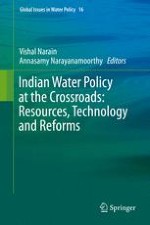2016 | OriginalPaper | Chapter
2. The Precept and Practice of Integrated Water Resources Management (IWRM) in India
Authors : Tushaar Shah, Barbara van Koppen
Published in: Indian Water Policy at the Crossroads: Resources, Technology and Reforms
Publisher: Springer International Publishing
Activate our intelligent search to find suitable subject content or patents.
Select sections of text to find matching patents with Artificial Intelligence. powered by
Select sections of text to find additional relevant content using AI-assisted search. powered by
